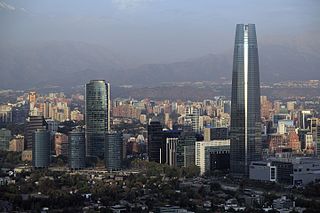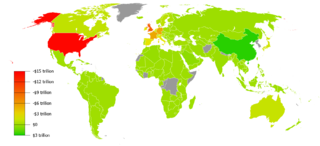
The economy of Chile is a market economy and high-income economy as ranked by the World Bank. The country is considered one of South America's most prosperous nations, leading the region in competitiveness, income per capita, globalization, economic freedom, and low perception of corruption. Although Chile has high economic inequality, as measured by the Gini index, it is close to the regional mean.

The economy of Indonesia is one of the emerging market economies in the world and the largest in Southeast Asia. As an upper-middle income country and member of the G20, Indonesia is classified as a newly industrialized country. Estimated at over 21 quadrillion rupiah in 2023, it is the 16th largest economy in the world by nominal GDP and the 7th largest in terms of GDP (PPP). Indonesia's internet economy reach US$77 billion in 2022, and is expected to cross the US$130 billion mark by 2025. Indonesia depends on the domestic market and government budget spending and its ownership of state-owned enterprises. The administration of prices of a range of basic goods also plays a significant role in Indonesia's market economy. However, since the 1990s, the majority of the economy has been controlled by individual Indonesians and foreign companies.

The economy of North Macedonia has become more liberalized, with an improved business environment, since its independence from Yugoslavia in 1991, which deprived the country of its key protected markets and the large transfer payments from Belgrade. Prior to independence, North Macedonia was Yugoslavia's poorest republic. An absence of infrastructure, United Nations sanctions on its largest market, and a Greek economic embargo hindered economic growth until 1996.

The economy of South Korea is a highly developed mixed economy. By nominal GDP, ₩2.24 quadrillion, it has the 4th largest economy in Asia and the 12th largest in the world. As it developed alongside Taiwan, Singapore, and Hong Kong, South Korea became known as one of the Four Asian Tigers. South Korea is notable for its rapid economic development from an underdeveloped nation to a developed, high-income country in a few generations. This economic growth has been described as the Miracle on the Han River, which has allowed it to join the OECD and the G-20. South Korea remains one of the fastest-growing developed countries in the world following the Great Recession and the COVID-19 recession. It is included in the group of Next Eleven countries as having the potential to play a dominant role in the global economy by the middle of the 21st century.

The 1997 Asian financial crisis was a period of financial crisis that gripped much of East and Southeast Asia during the late 1990s. The crisis began in Thailand in July 1997 before spreading to several other countries with a ripple effect, raising fears of a worldwide economic meltdown due to financial contagion. However, the recovery in 1998–1999 was rapid, and worries of a meltdown quickly subsided.

In international economics, the balance of payments of a country is the difference between all money flowing into the country in a particular period of time and the outflow of money to the rest of the world. These financial transactions are made by individuals, firms and government bodies to compare receipts and payments arising out of trade of goods and services.

The Bretton Woods system of monetary management established the rules for commercial relations among the United States, Canada, Western European countries, and Australia among 44 other countries after the 1944 Bretton Woods Agreement. The Bretton Woods system was the first example of a fully negotiated monetary order intended to govern monetary relations among independent states. The Bretton Woods system required countries to guarantee convertibility of their currencies into U.S. dollars to within 1% of fixed parity rates, with the dollar convertible to gold bullion for foreign governments and central banks at US$35 per troy ounce of fine gold. It also envisioned greater cooperation among countries in order to prevent future competitive devaluations, and thus established the International Monetary Fund (IMF) to monitor exchange rates and lend reserve currencies to nations with balance of payments deficits.
The Mexican peso crisis was a currency crisis sparked by the Mexican government's sudden devaluation of the peso against the U.S. dollar in December 1994, which became one of the first international financial crises ignited by capital flight.
Structural adjustment programs (SAPs) consist of loans provided by the International Monetary Fund (IMF) and the World Bank (WB) to countries that experience economic crises. Their stated purpose is to adjust the country's economic structure, improve international competitiveness, and restore its balance of payments.
The Convertibility plan was a plan by the Argentine Currency Board that pegged the Argentine peso to the U.S. dollar between 1991 and 2002 in an attempt to eliminate hyperinflation and stimulate economic growth. While it initially met with considerable success, the board's actions ultimately failed. The peso was only pegged to the dollar until 2002.
While beginning in the United States, the Great Recession spread to Asia rapidly and has affected much of the region.
This article is intended to give an overview of the trade policy of South Korea. In 1945 Korea was liberated from the Empire of Japan at the end of World War II. A destructive drought in 1958 forced Korea to import large amounts of food grains. In 1950, the Korean war broke out, which destroyed more than two-thirds of the nation's production facilities and most of its infrastructure. Trade policy of South Korea has taken many shifts, from import substitution to globalization and there has been significant impact on the economy for the same.
In 1945, China cofounded the International Monetary Fund (IMF) with 34 other nations. China was initially represented by the Republic of China. In April 1980, representation transferred to the People's Republic of China. The Chinese-IMF relationship mainly operates around affairs associated with IMF governance and the IMF Special Drawing Rights (SDR).
Vietnam joined the International Monetary Fund (IMF) on September 21, 1956, under the policy of Article VIII. Their quota contributes an estimated SDR of 1,153 millions and voting power of 0.24%. As of August 2016, the current IMF Resident Representative to Vietnam is Jonathan Dunn.

Poland was one of the founding members of the International Monetary Fund (IMF) in 1945. Under pressure from the Soviet Union, the country withdrew in 1950, believing that the organization had become a tool for the United States. Poland rejoined the IMF in 1986, following the end of martial law in Poland (1981–1983) and the withdrawal of the US veto against Polish membership.
The International Monetary Fund (IMF) has historically had a large presence in Indonesia, Southeast Asia's largest economy. During the Suharto era of the 1960s to 1990s the IMF enjoyed an active presence in the Indonesian economy and politics gaining influence through political sympathizers and technocrats within the Indonesian government. The early years of the Suharto era saw economic growth and modernization in a country that had only recently gained independence form Dutch colonialists. However, as the country modernized and growth slowed corruption became even more rampant particularly amongst the inner circle of the regime. After the fall of Suharto in 1998 the new elected government had a different approach to the IMF and was not so friendly towards restrictions on its economic decisions.
South Korea is 5th largest export economy in the world and the 6th economic complexity according to Economic Complexity Index (ECI) with the top export destinations centralized in China with a total population of 51,324,823 in 2019.

Bosnia and Herzegovina declared independence from the state formerly known as Yugoslavia in 1992 and joined the International Monetary Fund (IMF) on December 14, 1992. Bosnia and Herzegovina officially succeeded to the IMF membership of the former Yugoslavia on December 20, 1995, thereby giving the country access to the quota, as well as outstanding loans and payments, on behalf of Yugoslavia. Bosnia and Herzegovina, often synecdochically referred to as Bosnia, currently has an IMF quota of 265.20 million SDR. Bosnia is part of the constituency that contains primarily Eastern European countries but is led by the Netherlands and Belgium. Bosnia controls 4,117 votes of the constituencies 273,058 total votes, and the constituency overall accounts for 5.43% of the IMF's total votes. Since Bosnia joined the IMF in 1992, the country has utilized five borrowing arrangements, four of which were under the Stand-By Arrangements (SBA) and one of which was under the Extended Fund Facility (EFF). The first of the five arrangements was enacted in May 1998 and the most recent was enacted in September 2016. As of September 2019, Bosnia has 126.82 million SDR outstanding loans and/or purchases from the IMF.
The South Korean International Monetary Fund Agreement was implemented when South Korea, which was in a foreign exchange crisis, signed a memorandum of understanding with the International Monetary Fund on December 3, 1997. The country's chaebols, or large conglomerates, had engaged in poor business management and overborrowing, and the government had been supporting the chaebols' financial practices when the Asian financial crisis began. The IMF required the introduction of a range of policies as conditions for the bailout. The South Korean government under Kim Young-sam accepted those conditions to stave off a crisis. As a result, corporate bankruptcies, mass unemployment, and a crisis in the real economy accelerated.









